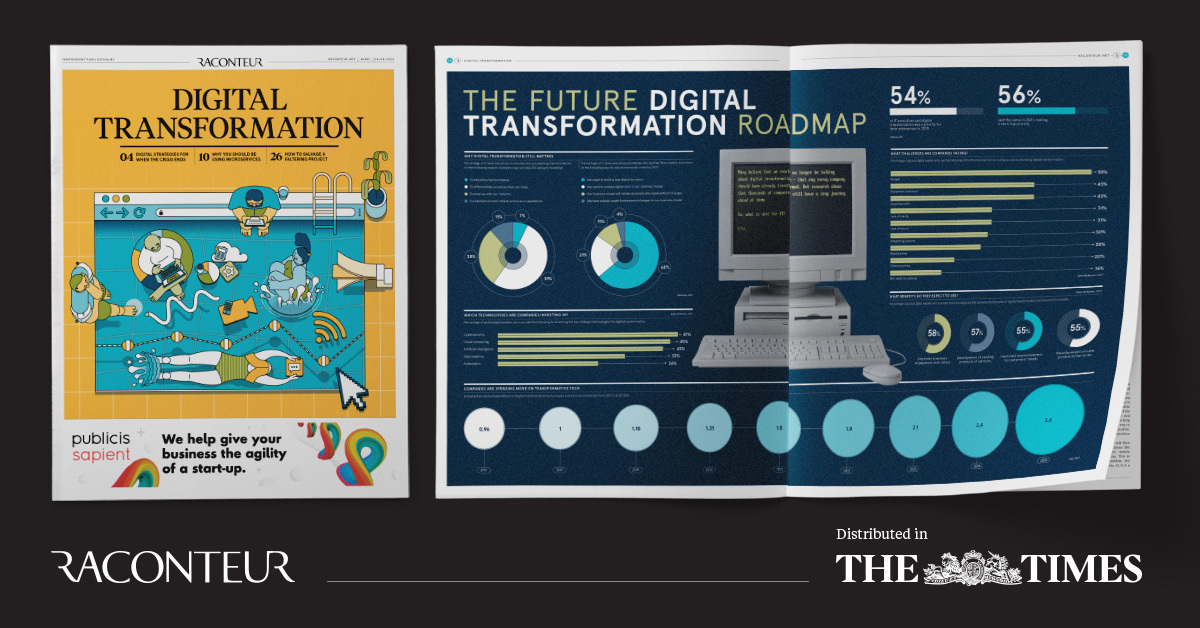As published in the Raconteur Digital Transformation Report in The Times
It’s been 10 years since digital transformation became a mainstream corporate strategy, but with confusion still around the term’s meaning, what do companies need to know now to take advantage of its benefits over the next decade?
The term “digital transformation” is now a decade old - with many experts acknowledging 2012 as the year it first entered the mainstream technology lexicon.
Since then, millions of global businesses have begun their digital transformation journey, but even 10 years on, much misunderstanding remains over what it means.
To clear up that confusion, here we explore what digital transformation signifies in 2022, and where it goes next…
The imperative for accepting “constant change”
Digital and technology is now all pervasive, touching both our personal and working lives in ways - and through tools - that didn’t exist a decade ago.
This means digital transformation can only succeed going forward if it is designed with a foundational acceptance that it now exists within a sphere of constant change.
Done right, it brings positive benefits, whether through increasing automation or adding greater levels of data and insights to base critical decisions on.
However, too many still attempt digital transformation for short-term pain relief or boardroom ‘theatre’. Too much money gets wasted on siloed projects to tick a box, and these make very little impact as a result.
Digital transformation must be embedded at the core of a company's culture, becoming a habit that's part of the DNA and personality
A mindset that's comfortable with uncertainty
Digital transformation must be embedded at the core of a company’s culture, becoming a habit that’s part of the DNA and personality, rather than a point in time to solve immediate issues.
Everyone from CEO to the ‘shopfloor’ must be totally comfortable with change; what some call VUCA: Volatility, Uncertainty, Complexity, and Ambiguity.
To keep pace with the market, companies must work constantly and consistently to identify what their next transformation looks like, and where their next change is coming from.
It’s not about how much money you spend, or how many ‘clever people’ you have, it starts and ends with accepting we must live with constant change.
Catching up with today’s digital expectations
We are now all awakened to the idea of user experience and so given the levels of technology used in our homes and workplaces, digital transformation must now meet a higher benchmark.
Many companies start a transformation only to watch it stall. Sometimes they become scared and uncomfortable with change internally, or, at other times, find it was poorly thought out.
I recently read a good example of this in Digital Darwinism by Tom Goodwin. Many airlines continue to upgrade tiny screens in their seatbacks, when instead they could provide strong in-flight Wi-Fi for passengers to stream on their own tablets and computers.
That would be a much more focused, sharper, and smarter way to digitally transform based on user experience, rather than legacy thinking.
Understanding the future needs of your talent
If you don’t have the right digital transformation plans, mindset, and culture, it will prevent you from attracting the best talent. Today’s digital natives will demand this; it is often more important to them than higher pay.
And digital transformation is just as important for retention.
When Palladium does due diligence, we identify red flags within the companies we work with. One of those is ‘toil’, the level at which employees begin to be dis-incentivised.
This can be avoided by automating repetitive tasks internally, in turn increasing productivity and profit.
Adopting ideals such as low-code can also upskill existing talent by democratising the best technological tools.
"One and done" isn't a strategy
Whatever stage of maturity a company is at with digital transformation, all that matters is staying focused on a mindset that accepts and celebrates constant change, and knows how and when to respond to it.
This means not jumping on every craze, bandwagon, or app that comes along, while dismissing old-style cognitive biases such as loss aversion and the sunk cost fallacy.
This is not a one and done investment or project. Agile thinking must instead harness constant evaluation, shorter feedback loops, and faster course correction - delivering on two-week horizons, rather than two months.
Yes, you might have sweated time, effort, and money to transform, only to learn that next week you’ve got to do it again.
But unless you’re a company who sees this as a positive benefit of constant change, you will not succeed in the longer term.

This article was published in the Raconteur Digital Transformation Report in The Times - you can read the full report here.
___________________________________________________________________
About Palladium
Palladium is an award-winning digital and technology due diligence provider and digital transformation partner to Private Equity firms and their portfolios across Europe and the US - providing advisory services throughout the transaction lifecycle. Palladium was named Gold and Overall Winner at the International Digital Experience Awards 2021.
Discover Palladium’s full range of capabilities in our latest case studies.



